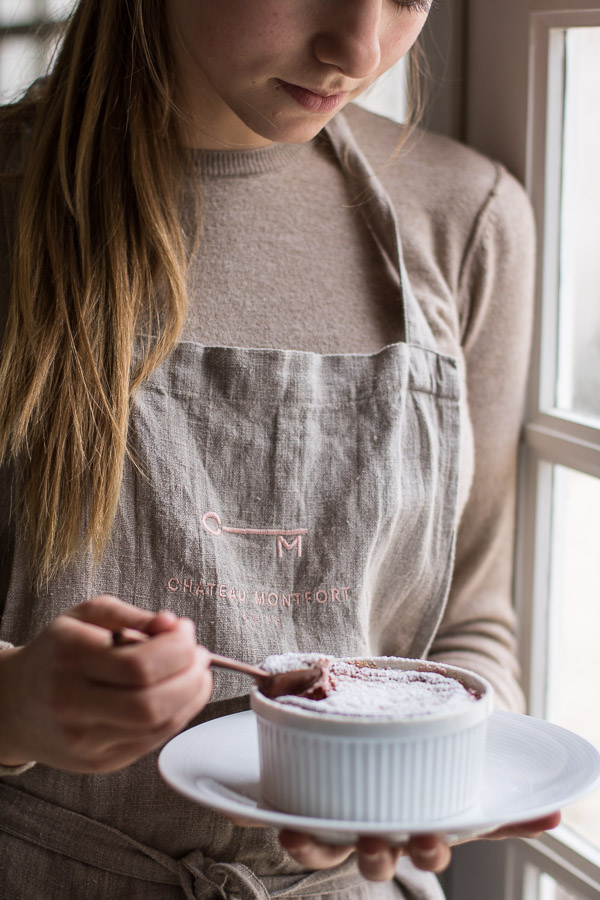
What goes up must come down. This picture of Annabelle was taken when she was eating one of the ‘spares’ later in the day!
Most villages in France have an auberge and if they don’t, there’s always one nearby. They’re the equivalent of an English country pub with a few first floor rooms for accommodation, only unlike an Australian pub, they’re missing the blowflies, poker machines, and a seedy beer-soaked bar mat. Our local auberge is so quintessentially French it could well be the poster girl of a national tourism campaign; creamy lime-rendered walls, French blue shutters, rattan bistro chairs on the terrace, blushing red geraniums, and an ancient stone fountain to justify its name, L’Auberge de la Fontaine à Laàs. It’s run by Jean-Luc Vicassiau and Suzy Praud Vicassiau; a husband and wife team who are equally as adorable as the Auberge itself. They’re also two of the hardest working people I’ve ever met, who unfailingly manage to welcome their patrons with a smile and two kisses like they’re part of the family and that’s exactly what if feels like to eat there; it’s like coming home.
The food at L’Auberge de la Fontaine is indisputably some of the very best auberge cuisine in the Béarn, prepared with the humility of a master chef with a light touch. Of the many dishes I’ve fallen in love with at this auberge, there’s one that I never fail to order, regardless of the season—dessert is always the Grand Marnier soufflé. It’s served in a pair of yellow and green striped ramekins, carried to the table like two generous bosoms wobbling on a plate. Why two? Perhaps they’re a homage to le buste d’Marianne, the revered French symbol of liberty. I have no idea and I’m not going to ask; two of Jean-Luc’s soufflés are most definitely better than one. Nor am I asking for the recipe. Sometimes it’s better not to know and revel in the mystery; at least that way I always have an excuse to return to the Auberge.
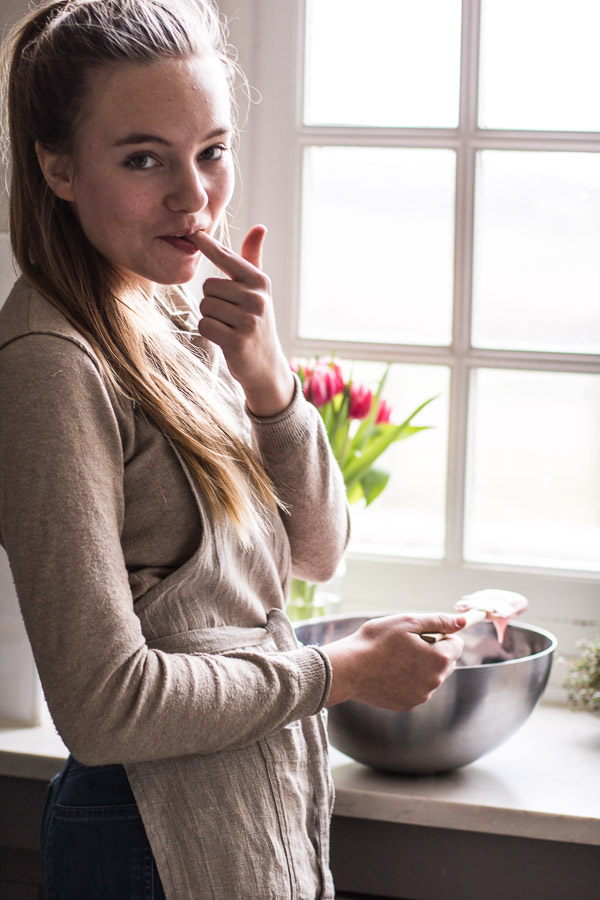
Some things are timeless. No matter how old you are, cooking with your mother always culminates with the reward of licking the spoon.
This recipe for raspberry soufflé is inspired by the soufflés at L’Auberge de la Fontaine, and the sensibility it’s chef Jean-Luc so deftly applies to showcasing local seasonal ingredients with great attention to detail, and yet, a complete lack of overcomplication. It’s the exact style of French cooking that inspired the Californian cuisine movement in the early 70’s and something that continues to inspire my own cooking on a daily basis. The Californian cuisine movement sprang from the kitchen of the incredible Alice Waters at Chez Panisse; the same kitchen that produced some of America’s greatest chefs including Jeremiah Tower, Wolfgang Puck, Judy Rodgers, Gilbert Pilgram and Dan Barber, to name a few.
“Let things taste of what they are.”
― Alice Waters, The Art of Simple Food: Notes, Lessons, and Recipes from a Delicious Revolution

This version of raspberry soufflé is from the Chez Panisse Fruit book. Unlike other soufflé recipes that incorporate flavorings into a classic pastry cream (or bechamel sauce in the case of a savory soufflé), this one combines a simple alcohol spiked raspberry purée with French meringue, resulting in a beautifully light soufflé that showcases the pure essence of the fruit. Its cooked at a higher temperature than the typical soufflé, so it does have a tendency to deflate a little quicker— making it that little bit harder for the amateur blogger/photographer/cook to adjust her aperture, dust with icing sugar and spring to the top of a kitchen stool in time to capture the full rise on camera. But trust me, if you’re simply cooking these soufflés for friends, you’ll have them on the table, fluffy heads held high, with plenty of time beforehand to send a sneaky snap to your mother.
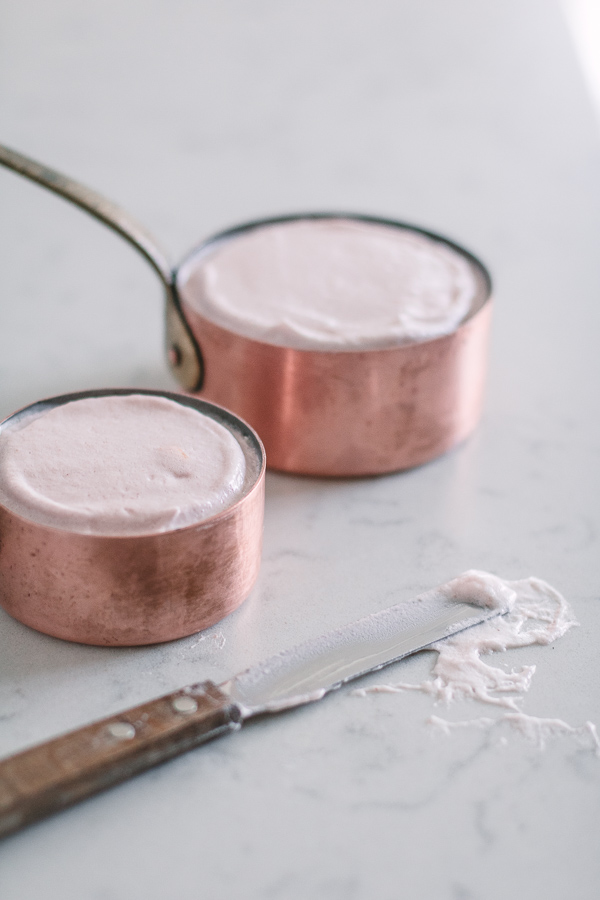
Soufflés seem to elicit sheer terror for the majority of cooks, but given some advanced preparation and timing, they’re actually quite a simple dish, with major kudos, particularly for those in need of seducing a potential mate. There are a few French classics I’m determined to teach my children before they leave home and this is one of them. Once you understand the basic components of a soufflê, you’ll be able to adapt it throughout the year to showcase everything from the simplicity of a sweet freshly shelled pea to a trio of cheeses. It’s these fundamentals that allow children to go on to be confident cooks and if there’s one concept I hope to teach my children, it’s that good food and accomplished home cooking is not about complicated techniques, its about knowing ingredients: knowing where they’re grown, how they grow, when they’re in season, what they taste like before they’re cooked, and knowing how to interfere with them just enough to transform them into something that celebrates their innate flavour and texture without destroying it. Learning to cook is about taste, touch, smell, and sound; everything children are pre-programmed to be fascinated by, and yet, everything modern day living has gradually stripped away and put inside a bar-coded packet. Fortunately, they haven’t managed to do that to a soufflé—yet!
For those tempted to launch into making a soufflé for the first time, here are a few no-fail tips:
- Oven temperature is really important. This recipe uses a hotter temperature to a usual soufflé recipe, but regardless, make sure your oven is properly preheated and once you put the soufflés inside, DON’T open it!
- Separate your egg whites (protein) and yolks (fat) carefully into perfectly clean bowls. If there’s a trace of egg yolk in the whites they won’t whip properly. If you really want to understand the science of protein and air bubbles, consult the bible: Harold McGee’s On Food and Cooking; The Science and Lore of the Kitchen
- Mix 1/3 of the egg whites with your flavour base (in this recipe the raspberry puree) well before incorporating the remainder of the egg whites— very gently.
- If you’re making soufflé for a dinner party, prep your ramekins beforehand. Also, prepare the fruit puree (or pastry cream if you’re making a traditional style souffle) in advance and have the dry ingredients ready to add to your pre-separated egg whites (always at room temperature)
- Once the ramekins are filled, give them a good tap on the bench top to remove any air pockets. This will ensure an even rise.
- Run your finger around the inside lip of the ramekin. This forms a little top hat in the mix which allows it to rise without catching on the rim, although, if you read the science, Harold McGee says this has nothing to do with the rise—it’s all down to pure physics in the end.
- Dust the cooked soufflés with icing sugar on the tray as soon as they come out of the oven then transfer them to a plate—a much less messy option than doing it individually.
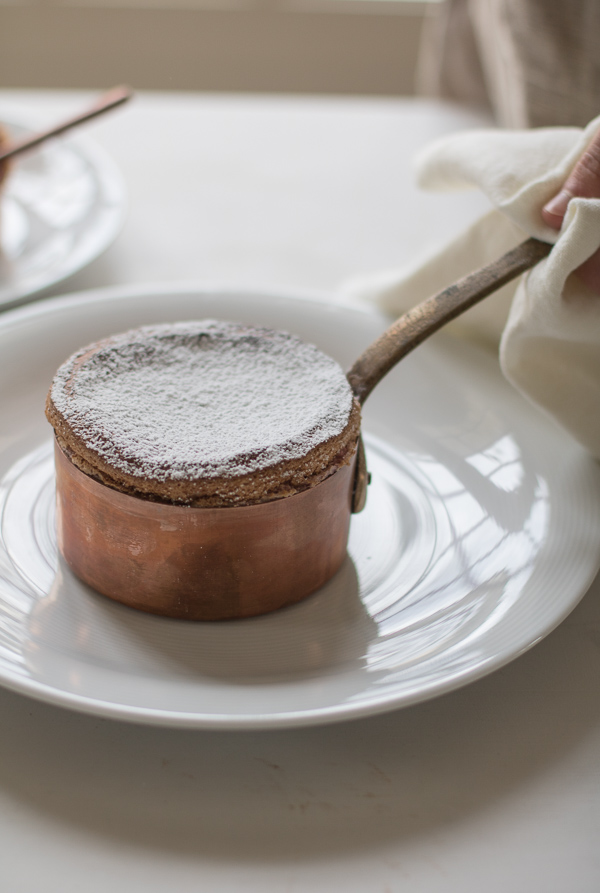
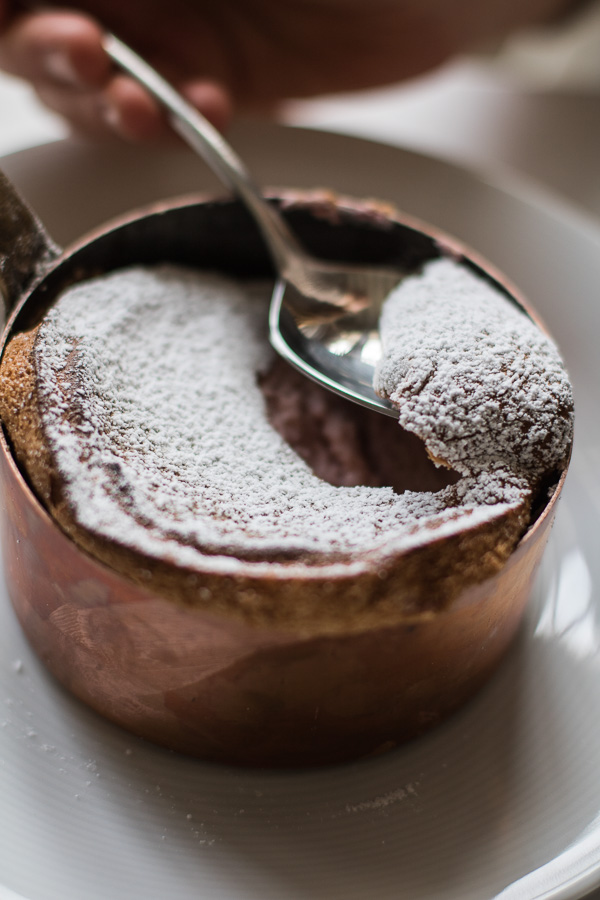
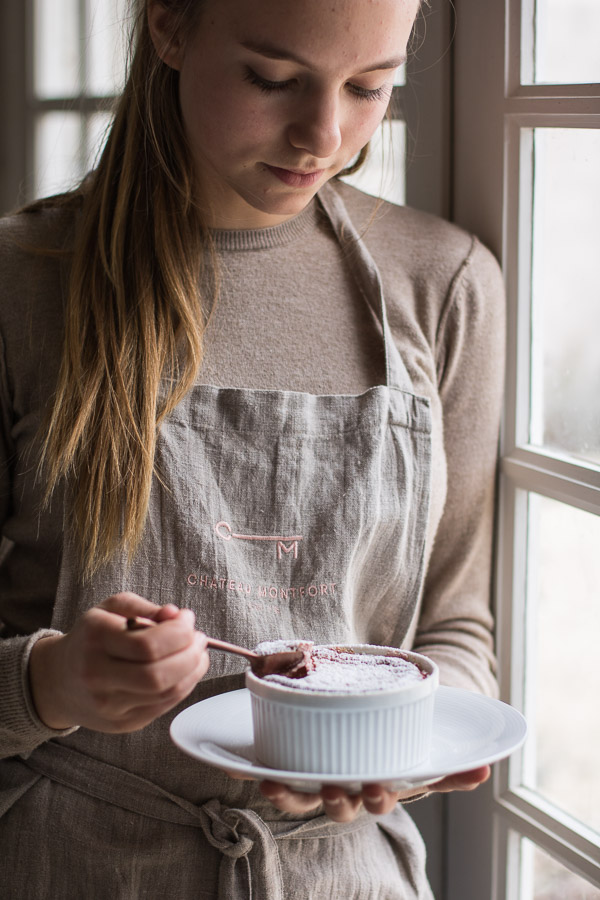

This picture was taken just a minute too late; the hazards of the cook also being the photographer, stylist… oh and the local pompiers arriving at the front door on their annual fund raising campaign!
Raspberry Soufflé
Ingredients:
For the Raspberry Purée:
-
300g fresh or frozen raspberries
-
50g granulated sugar
-
1 tablespoon lemon juice
For the Soufflé Base:
-
4 large egg yolks
-
70g granulated sugar
-
1½ tablespoons cornstarch
-
120g raspberry purée (prepared above)
-
1 tablespoon lemon juice
For the Meringue:
-
4 large egg whites, at room temperature
-
Pinch of cream of tartar
-
Pinch of kosher salt
-
50g granulated sugar
For Assembling:
-
Butter for greasing ramekins
-
Granulated sugar for coating ramekins
-
Powdered sugar for dusting
-
Fresh raspberries for garnish
Method:
-
Prepare the Raspberry Purée:
-
In a saucepan over medium heat, combine the raspberries, 50g sugar, and lemon juice. Cook, stirring occasionally, until the raspberries break down and the mixture thickens slightly, about 5-7 minutes.
-
Pass the mixture through a fine-mesh sieve to remove seeds, yielding approximately 120g of purée. Let it cool to room temperature.
-
-
Prepare the Soufflé Base:
-
In a medium bowl, whisk together the egg yolks, 70g sugar, and cornstarch until smooth.
-
Stir in the cooled raspberry purée and lemon juice until well combined.
-
-
Prepare the Meringue:
-
In a clean bowl, using an electric mixer, beat the egg whites with a pinch of cream of tartar and salt until soft peaks form.
-
Gradually add the 50g sugar, continuing to beat until stiff, glossy peaks form.
-
-
Assemble the Soufflés:
-
Preheat your oven to 190°C (375°F).
-
Butter four 6-ounce ramekins and coat them with granulated sugar, tapping out any excess.
-
Gently fold a third of the meringue into the raspberry mixture to lighten it.
-
Carefully fold in the remaining meringue until just combined, preserving as much air as possible.
-
Spoon the mixture into the prepared ramekins, smoothing the tops and wiping any excess from the rims to ensure even rising.
-
-
Bake:
-
Place the ramekins on a baking sheet and bake for 18-20 minutes, or until the soufflés have risen and are lightly browned on top.
-
-
Serve:
-
Remove from the oven and dust with powdered sugar.
-
Garnish with fresh raspberries and serve immediately.
-
Tips:
-
Meringue Stability: Ensure your mixing bowl and beaters are completely clean and free of grease to achieve stable meringue.
-
Serving Suggestion: Soufflés are best enjoyed immediately after baking, as they may begin to deflate over time.

+ ADD A COMMENT